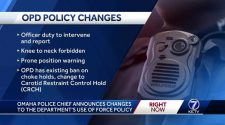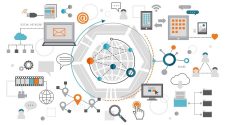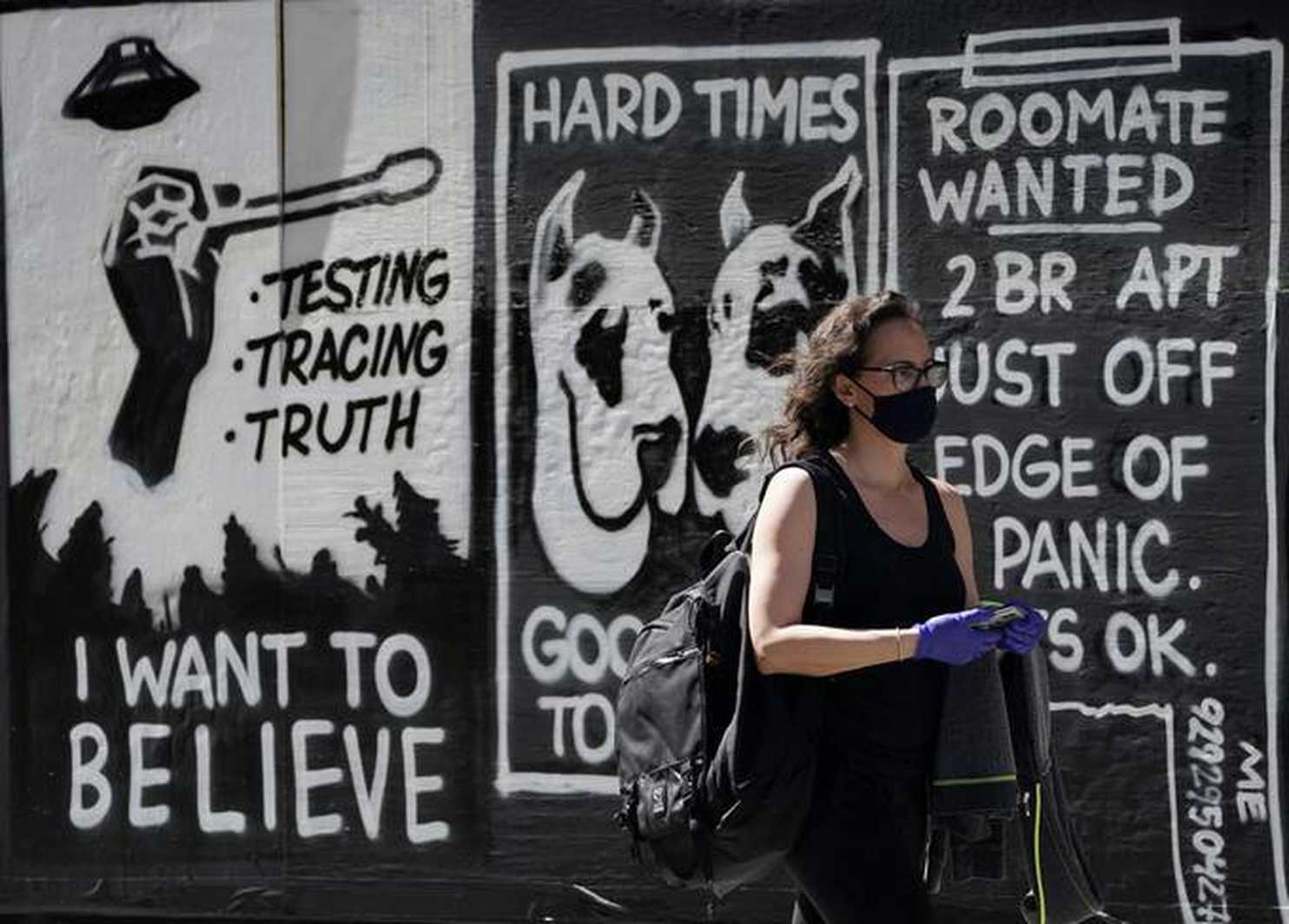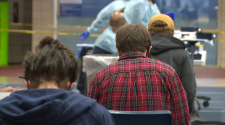with Paulina Firozi
Even as President Trump calls for a “transition to greatness” and many states lift social distancing restrictions, Americans are not expecting a quick return to normal amid the coronavirus pandemic. And they’re not optimistic that a vaccine is coming soon.
A spate of recent polls reveals Americans’ attitudes toward the novel coronavirus, which has taken the lives of 100,000 people in the United States.
Here’s what we learned.
A woman with a face mask walks by a mural by contemporary artist Stephen Powers, also known as ESPO, on Wednesday in New York. (Photo by Timothy A. Clary/AFP/Getty Images)
Nearly half of Americans say they or someone in their household skipped or delayed medical care because of the outbreak.
This is already having a negative effect on some people’s health: “The 48 percent who say there have been delays includes 11 percent who say a condition has worsened because of the missed care,” my colleague John Wagner reports for the live blog about a new KFF Health Tracking Poll.
Americans are, however, broadly hopeful that they will be able to get care soon. “Among those who say they have skipped care, most — 68 percent — say they expect to get the care within the next three months,” John writes.
“Most of those who have put off care due to coronavirus expect to get it soon,” KFF President and CEO Drew Altman said in a statement. “If they do, health care utilization may bounce back more quickly than the rest of the economy.”
Americans are likelier to see a health-care provider than they are to resume other activities.
The KFF poll found that 82 percent of Americans say it’s likely they will go to a dental or medical appointment in person over the next three months, or are already doing it.
That’s striking considering most Americans appear to expect the virus will upend their summer plans. Just 19 percent say they will go to a concert or sporting event in the next three months. Only 23 percent said they would go on an airplane and 32 percent would stay in a hotel. Americans were split — 53 percent — on whether they expected to dine in-person at a restaurant.
Their level of comfort with daily activities also seemed to be split along party lines: “[M]ajorities including most Republicans and independents … expect to be getting back to some usual activities in the coming months such as going to the doctor, going to a barber or salon, attending larger gatherings, or eating in a restaurant. Most Democrats say it is unlikely they will be doing any of these activities except for going to a doctor or health care provider.”
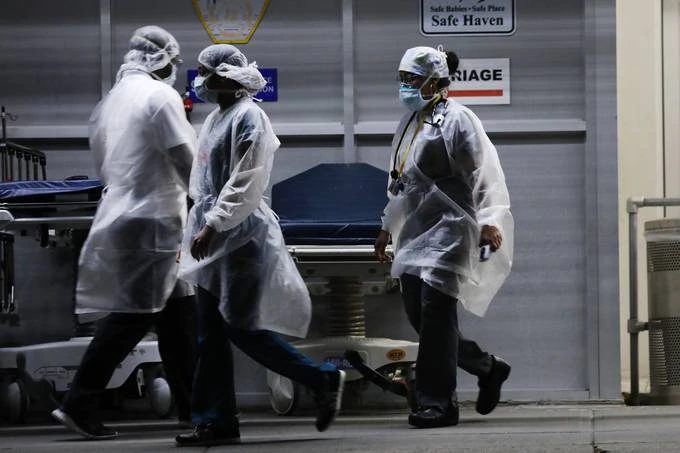
Medical workers walk outside a special coronavirus area at Maimonides Medical Center in Brooklyn on Tuesday. (Spencer Platt/Getty Images)
Stress related to the coronavirus crisis is affecting people’s mental health.
“About four in ten U.S. adults (39%) say worry or stress related to coronavirus has had a negative impact on their mental health, including 12% who say it has had a ‘major’ impact,” the KFF poll finds. “This is down slightly from early April when 45% reported a negative mental health impact.”
This generally lines up with stark findings gleaned from Census Bureau data. “A third of Americans are showing signs of clinical anxiety or depression, Census Bureau data shows, the most definitive and alarming sign yet of the psychological toll exacted by the coronavirus pandemic,” my colleagues Alyssa Fowers and William Wan report.
“When asked questions normally used to screen patients for mental health problems, 24 percent showed clinically significant symptoms of major depressive disorder and 30 percent showed symptoms of generalized anxiety disorder,” they write. “The findings suggest a huge jump from before the pandemic. For example, on one question about depressed mood, the percentage reporting such symptoms was double that found in a 2014 national survey.”
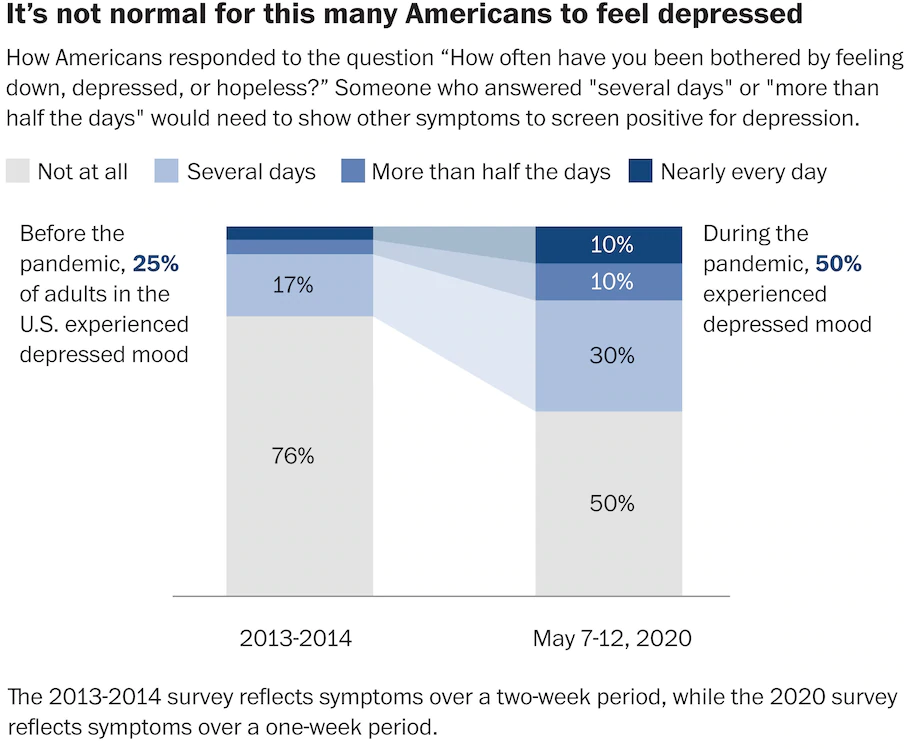
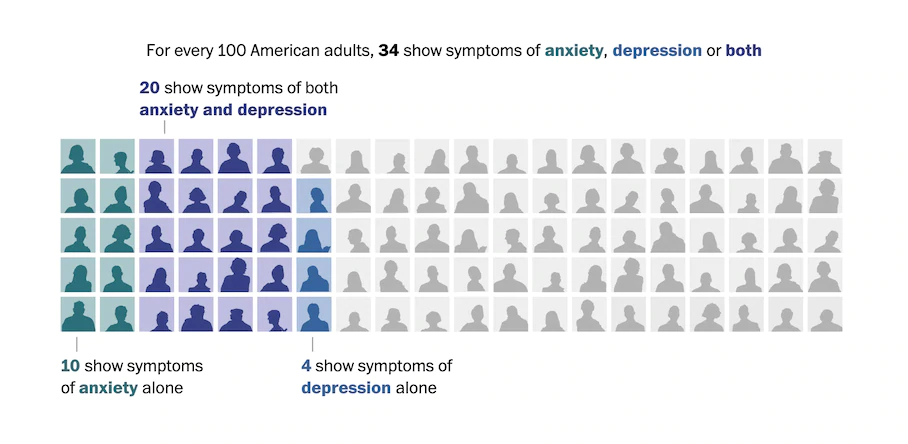
The KFF poll found a gender and demographic split on this: “[W]omen continue to be more likely than men to say it is has negatively impacted their mental health (46% vs 33%) and urban (46%) and suburban (38%) residents are more likely than those in rural areas (28%) to say coronavirus has had a negative impact on their mental health.”
And people’s individual economic situations are, not surprisingly, playing a role: “Among adults in households that experienced income or job loss due to the coronavirus outbreak (who make up one-third of adults overall), 46% say the pandemic has had a negative impact on their mental health.”
Only 1 in 5 Americans believe Trump’s promise to have a vaccine available by the end of the year.
A poll from Associated Press-NORC Center for Public Affairs Research found that only 20 percent of Americans believe that goal — what public health experts call a very ambitious timetable — would be met, John writes.
There are brighter hopes for 2021: As John writes, 61 percent expect a vaccine to become available sometime next year, though 17 percent think it will take longer than that.
But only half of Americans say they would definitely get vaccinated against coronavirus once it becomes available.
Just “49 percent plan to get vaccinated while 31 percent say they are not sure,” John writes of the AP-NORC poll. “Twenty percent say they will not get vaccinated.”
Notably: “The percentage of those who say they definitely would get vaccinated is about the same as those who said they planned to get vaccinated against the flu in a 2019 survey conducted for the National Foundation for Infectious Diseases.
“In the AP-NORC poll, 70 percent of those who do not plan to get vaccinated cite possible side effects among the reasons. Forty-two percent say they fear getting infected with the coronavirus from the vaccine, while 31 percent say they are not concerned about getting seriously ill from the coronavirus.”
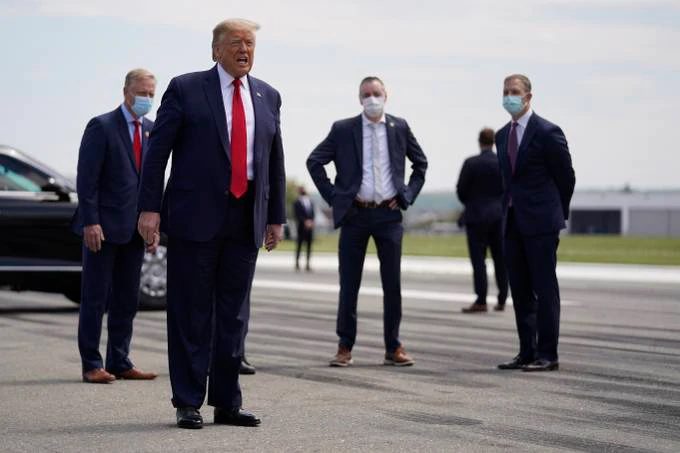
President Trump speaks after exiting Air Force One at Lehigh Valley International Airport in Allentown, Pa., on May 14. (Evan Vucci/AP)
Americans are split along party lines on mask-wearing.
Masks have become a politically charged issue, with Trump’s recent mockery of wearing cloth face coverings dividing Republican political leaders.
The KFF poll finds that “Democrats are almost twice as likely as Republicans (70% v. 37%) to say they wear a mask ‘every time’ they leave their house and while most people (72%) think President Trump should wear a mask when meeting with other people, only about half of Republicans (48%) agree.”
There’s a gender divide here too: “The partisan difference in opinion and behavior regarding masks is largely driven by Republican men. About half of Republican men report wearing a protective mask at least most of the time when leaving their house to go someplace where they may come into contact with others (49%) and smaller shares say President Trump should wear a mask when meeting with other people (43%).”
Ahh, oof and ouch
AHH: The death toll in the United States has reached 100,000.
The 100,000 are overwhelmingly elderly and disproportionately poor and black and Latino. Many of them were essential workers, doing work that allowed others to stay home.

Each death is represented as a ray of light. (Map illustration by Lauren Tierney and Tim Meko/The Washington Post)
“The demise of these 100,000 people has had strangely little public impact in a country with a long history of honoring its fallen and committing to common cause in their memory,” Marc Fisher reports. “Americans have responded to the coronavirus pandemic with outpourings of gratitude — New Yorkers’ nightly chorus of cheers for health-care workers, for example — and widespread cooperation, including extraordinary, quick pivots to staying at home and wearing masks. But there have been few expressions of public grief — no gold stars in the windows of homes where people died, no outcry for national unity or memorials, as happened after the Sept. 11, 2001, terrorist attacks.”
“Maybe,” said Lauren Berlant, a University of Chicago professor whose work focuses on compassion, “it’s hard to mourn when you’re busy trying to sustain life.”
The Washington Post has a continually updating series telling the stories of those who have died — who they were and how they lived. Read about their lives here.
OOF: The coronavirus may never go away, even with a vaccine.
Experts say that kind of long-term thinking is critical to enter the next phase of the country’s response to the pandemic.
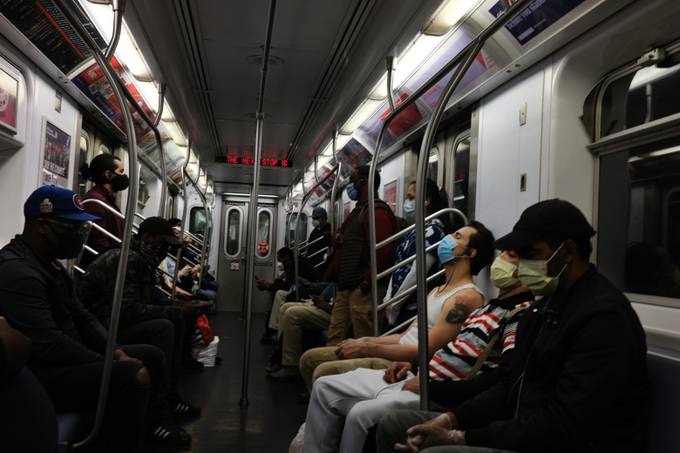
The persistence of the novel coronavirus is one of the few things we can count on. In New York, after subway ridership plummeted more than 90 percent, commuters are slowly returning, albeit with masks. (Spencer Platt/Getty Images)
“Experts call such diseases endemic — stubbornly resisting efforts to stamp them out. Think measles, HIV, chickenpox,” William Wan and Carolyn Y. Johnson report. But despite the daunting proposition, experts say the long-term nature of the disease caused by the coronavirus “should serve as a call to arms for the public, a road map for the trillions of dollars Congress is spending and a fixed navigational point for the nation’s current, chaotic state-by-state patchwork strategy.”
The long-term existence of the virus, however, doesn’t mean that situation will always be as dire as it is now.
“There are already four endemic coronaviruses that circulate continuously, causing the common cold. And many experts think this virus will become the fifth — its effects growing milder as immunity spreads and our bodies adapt to it over time,” William and Carolyn write.
“Eventually, everyone is going to know someone who got infected or died from this virus,” said Michael T. Osterholm, director of the University of Minnesota’s Center for Infectious Disease Research and Policy. “That’s what it may take.”
OUCH: Small hospitals in Southern California have been flooded with Americans who have fallen ill and crossed the border from Mexico.
“They are retirees and dual citizens, Americans working in Mexico or visiting family there,” Kevin Sieff reports. “It is an example of how easily the virus moves between countries, even as governments — and particularly the Trump administration — have attempted to shut their borders. And it’s a window into how many American lives span the U.S.-Mexico border, including families who have moved freely across the region since before that line was drawn and whose movement has continued during the pandemic.”
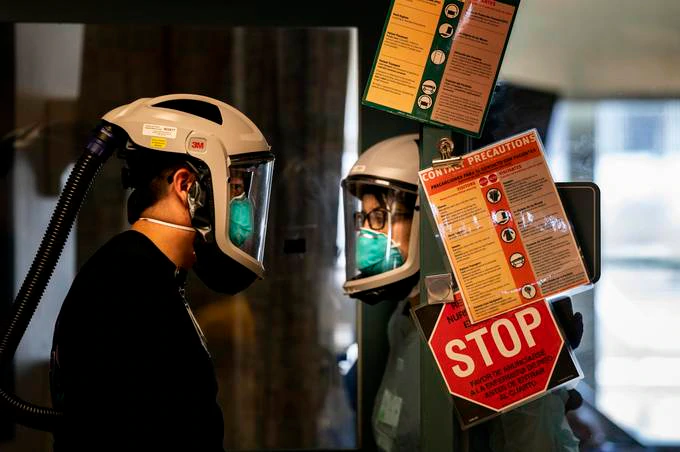
Nurses and respiratory specialists treat coronavirus patients in the intensive care unit of the El Centro Regional Medical Center in El Centro, Calif. (Melina Mara/The Washington Post)
About half of the coronavirus patients in numerous hospitals on the California border are recent arrivals from Mexico. That flood of patients has created an unprecedented hurdle for small community hospitals.
“El Centro Regional normally serves a county with a population of about 180,000 residents, many of whom live below the poverty line,” Kevin writes. “Suddenly, the hospital was responding to an additional community of Americans in Mexicali, thought to number 100,000 people.”
“It’s amazing how this disease has taught us that borders don’t exist,” said Adolphe Edward, the chief executive of El Centro Regional.
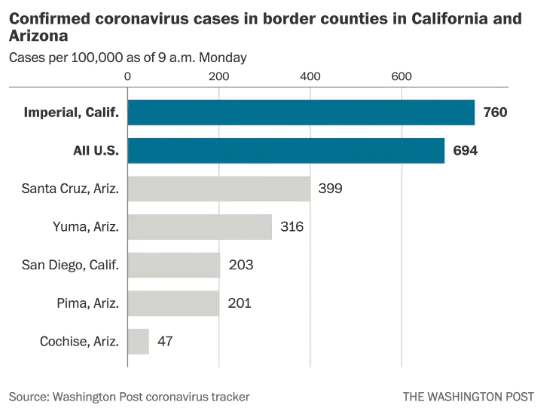
Congress on coronavirus
House lawmakers yesterday conducted their first remote vote in the body’s 231-year history.
It’s a temporary measure that was pushed forward by House Speaker Nancy Pelosi (D-Calif.) and fellow Democratic leaders to allow lawmakers to participate amid the pandemic.
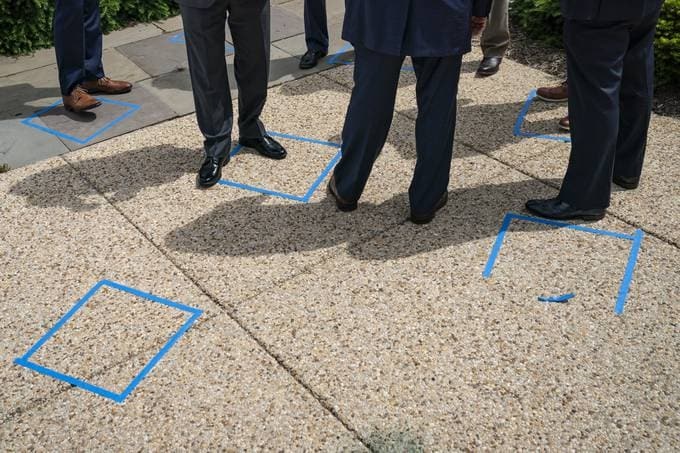
House Republican members gather before a news conference outside the U.S. Capitol. (Drew Angerer/Getty Images)
But the vote occurred as Republican leaders filed a federal lawsuit challenging the move’s constitutionality.
“Several Democrats have fretted about the House’s effectiveness as the outbreak has sidelined lawmakers — while other parts of the federal government have adapted to the new reality and the Senate, with fewer members, has returned to Washington to vote on nominations and legislation,” Mike DeBonis reports.
He adds: “Under rules adopted earlier this month, 71 House members filed letters designating a colleague to cast floor votes on their behalf during the pandemic while they remain away from the Capitol. One by one Wednesday, dozens of Democrats stood at the microphones Wednesday afternoon and announced — most of them through masks — how the absent members were voting.”
Coronavirus latest
The Trump administration’s response:
- Trump has been uncharacteristically silent as the nation reached its bleak 100,000-death milestone. But the president — who has spent his life fixated on metrics — has no special commemoration or moment of silence on his public schedule, as Ashley Parker writes.
- Joe Biden argued the United States’ 100,000 death toll could have been avoided if the administration acted sooner. “It’s made all the worse by knowing that this is a fateful milestone we should have never reached, that could have been avoided,” he said in a video posted from his Delaware home.
- Anthony S. Fauci, the director of the National Institute of Allergy and Infectious Diseases, said that apart from wearing a face covering because “I believe it is effective,” he wants to “make it be a symbol for people to see that that’s the kind of thing you should be doing.” “It’s not 100 percent effective. I mean, it’s sort of respect for another person, and have that other person respect you,” he said in an interview on CNN. “You wear a mask, they wear a mask, you protect each other.”
In the states:
- New York Gov. Andrew Cuomo (D) defended the need for federal funding for hard-hit states. “Stop abusing New York. Stop abusing New Jersey. Stop abusing Massachusetts and Illinois and Michigan and Pennsylvania,” Cuomo said at a briefing at the National Press Club after meeting with Trump. “Stop abusing the states who bore the brunt of the covid virus through no fault of their own.”
- New York City’s daily death toll is declining. But what’s next is tricky. “History, economics and the gritty, no-nonsense will of its residents suggest the city will recover, but the facts on the ground point to the array of obstacles confronting dancers, property owners, restaurateurs, manicurists, finance executives and the other faces that make the city tick,” the Wall Street Journal’s Jon Hilsenrath and Kate King report.
- As of last week, New Jersey was testing 20,000 to 30,000 people a day, above the 20,000-test benchmark Gov. Phil Murphy (D) set this month, Politico’s Sam Sutton reports.
In the region:
- The District of Columbia will take tentative steps to start reopening on Friday. “For the first time in nearly two months, Washingtonians will be able to dine at a restaurant (outside seating only), get a haircut and shop curbside from stores deemed nonessential,” Fenit Nirappil, Emily Davies and Ovetta Wiggins report. “Indoor worship services will be capped at 10 people and gyms, pools and day camps will still be shuttered.”
On the front lines:
- First responders are facing a daily source of tension: whether to limit their mask use given the limited supplies of N95 masks, Dan Morse reports.




